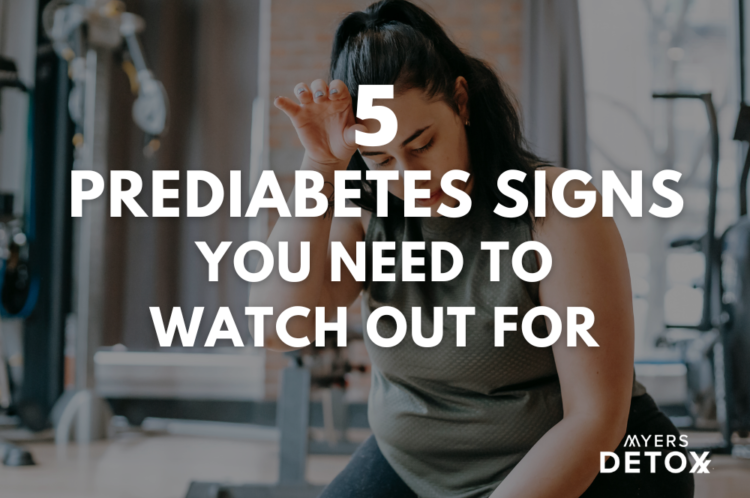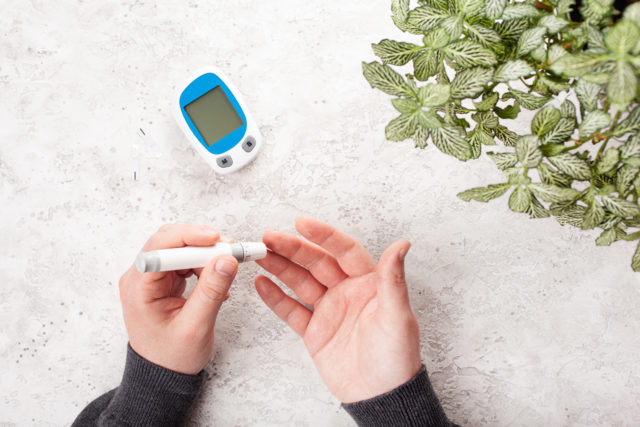5 Prediabetes Signs You Need To Watch Out For

Concerned about diabetes? Read on to learn the 5 prediabetes signs you need to watch out for!
Metabolic conditions like diabetes have been on the rise in Western culture for several decades, and the trends don’t look like they’re turning around any time soon.
Diet and lifestyle play a vital role in the onset of diabetes, and having the right resources and knowledge can help prevent this condition or stop it in its tracks if it is in the beginning stages.
The key is knowing what to watch out for and keeping an eye on your health markers.
Check out the video above and then come back! We will dig a little deeper in this article and discuss:
- Five signs of prediabetes that you need to watch out for
- The connection between heart disease and diabetes
What Is Prediabetes?

Prediabetes is a precursor to diabetes where blood sugar levels are above normal but not yet high enough to be considered full-blown diabetes. At this stage, you may start having health markers that could lead to some of the complications associated with diabetes, such as heart disease and obesity, but there is still time to turn things around.
The exact cause of prediabetes and diabetes isn’t completely understood. However, genetics and family history seem to play a role. Furthermore, lifestyle factors such as being overweight, not exercising, and having a poor diet also contribute.
Type 2 diabetes occurs when your cells are unable to respond to the hormone insulin. Insulin is released in response to glucose (sugar) in your blood and acts as a chauffeur shuttling the glucose out of the blood and into your cells. When your cells aren’t responding to insulin properly, it leads to a buildup of sugar in the blood. High blood sugar can damage blood vessels and organs and lead to problems with your nerves[1].
In prediabetes, your cells have begun to become insensitive to insulin. This leads to a gradual buildup of sugar in your blood, much like full-blown diabetes, except on a smaller scale. If prediabetes goes unmanaged, it will likely develop into type 2 diabetes, where your cells become highly insensitive to glucose[2].
The generally accepted number for prediabetes versus type 2 diabetes are:
- Prediabetes: a fasting blood glucose of 100 mg/dL to 125 mg/dL
- Type 2 diabetes: blood glucose is greater than 180 mg/dL one to two hours after eating
The good news is that when you’re in the prediabetes stage, there is still time to make changes and stop diabetes from progressing. Therefore, keeping an eye on the signs that prediabetes may be developing is crucial for staying on track with your health.
Five Prediabetes Signs You Need To Watch Out For

Below are five warning signs associated with prediabetes.
#1 Irregular Blood Sugar
Of course, the most obvious sign of prediabetes is irregular blood sugar. If you have your blood sugar levels tested and are within the prediabetes stage, you will know that you have some work to do to get those numbers down. But you can also become aware of your blood sugar by paying attention to how you feel throughout the day.
When blood sugar is irregular, you may notice sudden dips in energy, excessive hunger, or brain fog. This is due to the inability of your cells to utilize glucose properly and therefore make enough energy.
#2 Excessive Thirst and Urination
Many people with diabetes and prediabetes experience excessive thirst and urination. This is primarily due to the fact that your kidneys have to work extra hard to filter out excessive amounts of glucose.
Your kidneys try to remove all the excess glucose from your body by carrying it out in your urine. During this process, fluids from your body are excreted along with glucose – making you feel dehydrated. As a result, you’ll notice excess urination as well as an increased thirst to compensate for the loss of fluid.
#3 Weight Gain Around The Middle
Obesity, in general, is strongly correlated with the onset of diabetes and heart disease. However, weight gain around the middle has a much stronger correlation than general weight gain.
Research shows that abdominal obesity may directly impact insulin sensitivity through a number of pathways, including inflammation. Investigators are still unsure why it is that abdominal obesity is a greater risk factor than general weight gain, but it likely has to do with the function of fat cells around the middle and their impact on metabolic health[3][4].
#4 Fatigue
While many health imbalances can lead to fatigue, prediabetes and diabetes are often accompanied by fatigue due to the direct impact these conditions have on glucose homeostasis. Since glucose is your body’s primary source of fuel, when your cells aren’t able to take up glucose from your blood, they become starved for energy.
Furthermore, your water balance will also be off due to the dehydrating impact of excess glucose being removed from the kidneys. Having enough water in your body is vital to energy production due to water’s role in carrying nutrients to your cells.
With a combination of not enough energy from glucose, plus a lack of water, fatigue often ensues[5].
#5 High Blood Pressure
Around two out of three people with diabetes also report high blood pressure[6].
The exact mechanism by which diabetes and high blood pressure are related isn’t completely clear, but researchers believe it is a combination of co-occurring issues such as obesity, inflammation, and oxidative stress[7].
Furthermore, the damage that diabetes may have on your blood vessels may also play a role.
Due to the impact that high blood sugar has on your blood vessels, prediabetes may cause high blood pressure by impacting the flexibility of your blood vessels. When your blood vessels become damaged or stiff, it makes it more challenging to allow blood flow through, leading to elevated blood pressure.
Symptoms of high blood pressure include headache, dizziness, and blurred vision[8].
Lifestyle Tips To Turn Around Prediabetes

Exercise
One of the most effective ways to help your cells become sensitive to insulin once again is through exercise. When you move, your cells become more attuned to their glucose needs as you start utilizing your energy stores. As a result, your cells create more insulin receptors, which makes them hungrier for glucose[9].
Food
The food you eat will directly impact the way your body processes energy. If you are constantly flooding your system with high carbohydrate foods, you’ll be putting your hormones to work to try to remove the extra sugar from your blood.
This is true whether you have prediabetes or not.
To make things easier on your energy processes, try to balance your meals with sufficient protein, fiber, and fat[10].
Research shows that soluble fiber, in particular, may decrease insulin resistance in people with diabetes and prediabetes. Some examples of foods high in soluble fiber include beans, brussels sprouts, broccoli, avocado, and sweet potatoes[11].
Lose Weight
Weight loss, especially around the middle, is a fantastic way to start reversing prediabetes. Of course, weight loss that’s obtained by consuming a healthy diet and exercising more will provide the most benefit as it will draw in the positive impact of both diet and movement.
Research shows that people with prediabetes that lose around 10% of their body weight in six months have a dramatic reduction in the risk of developing full-blown diabetes[12].
Takeaway
Diabetes is a growing concern in the US, with around 10% of the population currently diagnosed, about 34 million people. Although this number is certainly staggering, lifestyle and dietary adjustments can go a long way to turn things around[13].
The most important thing you can do for your health is to be aware of how you feel and what’s happening with your health markers on a day-to-day basis. Watch your energy levels and symptoms like dehydration, excessive urination, and headaches. In addition, keep an eye on blood sugar levels, inflammation, and blood pressure.
Click Here for References+
- https://my.clevelandclinic.org/health/diseases/9815-hyperglycemia-high-blood-sugar
- https://www.mayoclinic.org/diseases-conditions/prediabetes/symptoms-causes/syc-20355278
- Despres, J. P. “Intra-abdominal obesity: an untreated risk factor for Type 2 diabetes and cardiovascular disease.” Journal of endocrinological investigation 29.3 (2006): 77.
- Lee, Jane J., S. Natasha Beretvas, and Jeanne H. Freeland-Graves. “Abdominal adiposity distribution in diabetic/prediabetic and nondiabetic populations: a meta-analysis.” Journal of obesity 2014 (2014).
- https://www.health.harvard.edu/healthbeat/fight-fatigue-with-fluids
- https://www.diabetes.org/diabetes/high-blood-pressure
- Cheung, Bernard MY, and Chao Li. “Diabetes and hypertension: is there a common metabolic pathway?.” Current atherosclerosis reports 14.2 (2012): 160-166.
- https://www.hopkinsmedicine.org/health/conditions-and-diseases/diabetes/diabetes-and-high-blood-pressure
- Flores-Opazo, Marcelo, Sean L. McGee, and Mark Hargreaves. “Exercise and GLUT4.” Exercise and sport sciences reviews 48.3 (2020): 110-118.
- Te Morenga, Lisa, et al. “The effect of a diet moderately high in protein and fiber on insulin sensitivity measured using the Dynamic Insulin Sensitivity and Secretion Test (DISST).” Nutrients 9.12 (2017): 1291.
- Dong, Yutong, et al. “Total, insoluble, and soluble dietary fiber intake and insulin resistance and blood pressure in adolescents.” European journal of clinical nutrition 73.8 (2019): 1172-1178.
- https://www.hopkinsmedicine.org/news/media/releases/people_with_pre_diabetes_who_drop_substantial_weight_may_ward_off_type_2_diabetes#:~:text=People%20with%20pre%2Ddiabetes%20who%20lose%20roughly%2010%20percent%20of,led%20by%20Johns%20Hopkins%20scientists
- https://www.cdc.gov/diabetes/pdfs/data/statistics/national-diabetes-statistics-report.pdf









